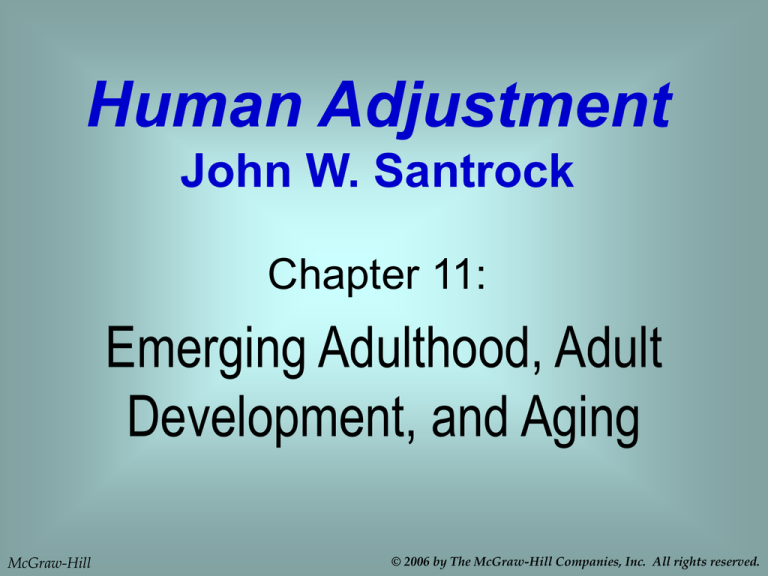
Human Adjustment
John W. Santrock
Chapter 11:
Emerging Adulthood, Adult
Development, and Aging
McGraw-Hill
© 2006 by The McGraw-Hill Companies, Inc. All rights reserved.
11-2
Chapter Outline
Becoming an Adult
Physical Development in Adulthood
Cognitive Development in Adulthood
Socioemotional Development in Adulthood
Death and Grieving
McGraw-Hill
©2006 by the McGraw-Hill Companies, Inc. All rights reserved.
11-3
Learning Goals
1. Describe the nature of development and becoming
an adult
2. Explain physical changes in adulthood
3. Characterize cognitive changes in adulthood
4. Summarize socioemotional changes in adulthood
5. Discuss death and grieving
McGraw-Hill
©2006 by the McGraw-Hill Companies, Inc. All rights reserved.
11-4
BECOMING AN ADULT
The Nature of Development
Emerging Adulthood
McGraw-Hill
©2006 by the McGraw-Hill Companies, Inc. All rights reserved.
11-5
The Nature of Development
Development = pattern of change in human
capabilities that begins at conception and continues
through the lifespan
McGraw-Hill
©2006 by the McGraw-Hill Companies, Inc. All rights reserved.
11-6
The Nature of Development
The pattern of development is the product of:
– Physical processes - changes in individual’s biological
nature
– Cognitive processes - changes in individual’s thinking,
intelligence and language
– Socioemotional processes - changes in individual’s
relationships with other people, emotions, and personality
McGraw-Hill
©2006 by the McGraw-Hill Companies, Inc. All rights reserved.
11-7
Figure 11.1 Developmental Changes are the Result of
Physical, Cognitive, and Socioemotional Processes
McGraw-Hill
©2006 by the McGraw-Hill Companies, Inc. All rights reserved.
11-8
Adult Periods of Development
Early adulthood - begins in late teens/early 20s and
lasts through the 30s
Early adulthood is a time of:
– establishing personal and economic independence
– developing a career
– selecting a mate
– learning to live with someone in an intimate way
– starting a family
– rearing children
McGraw-Hill
©2006 by the McGraw-Hill Companies, Inc. All rights reserved.
11-9
Adult Periods of Development
Middle adulthood - period from 40 years of age to
about 60
Middle adulthood is time of:
– expanding personal and social involvement and
responsibility
– assisting next generation in becoming competent, mature
individuals
– reaching and maintaining satisfaction in a career
McGraw-Hill
©2006 by the McGraw-Hill Companies, Inc. All rights reserved.
11-10
Adult Periods of Development
Late adulthood - period that begins in the 60s and
lasts until death
Late adulthood is the time of:
– adjusting to retirement
– decreasing strength and health
– new social roles
– reviewing one’s life
McGraw-Hill
©2006 by the McGraw-Hill Companies, Inc. All rights reserved.
Figure 11.2 Degree of Personal Life
Investment at Different Points in Life
McGraw-Hill
11-11
©2006 by the McGraw-Hill Companies, Inc. All rights reserved.
11-12
Emerging Adulthood
Emerging Adulthood = term for the transition from
adolescence to adulthood (18 to 25 years of age)
that is characterized by experimentation and
exploration
McGraw-Hill
©2006 by the McGraw-Hill Companies, Inc. All rights reserved.
11-13
Who Is an Adult?
Determining just when an individual becomes an adult
is difficult
Some markers include:
– marriage
– full-time job
– economic independence
– self-responsibility
McGraw-Hill
©2006 by the McGraw-Hill Companies, Inc. All rights reserved.
Adjustment Strategies
for Emerging Adulthood
11-14
1. Experiment and explore responsibility
2. Develop intellectual assets
3. Create psychological assets
4. Establish social assets
McGraw-Hill
©2006 by the McGraw-Hill Companies, Inc. All rights reserved.
11-15
Adapting to College
Going from being a senior in high school to being a
freshman in college brings many changes
Special challenges face students who are returning
students - students who either did not go to college
right out of high school or went to college, dropped out,
and now have returned
McGraw-Hill
©2006 by the McGraw-Hill Companies, Inc. All rights reserved.
Adjustment Strategies
for Returning Students
11-16
1. Develop strategies to cope with new environment
2. Connect with your campus
3. Get to know other students
4. Take advantage of support services
McGraw-Hill
©2006 by the McGraw-Hill Companies, Inc. All rights reserved.
11-17
Review - Learning Goal 1
– How can development be characterized?
– What is emerging adulthood?
McGraw-Hill
©2006 by the McGraw-Hill Companies, Inc. All rights reserved.
PHYSICAL DEVELOPMENT
IN ADULTHOOD
11-18
Early Adulthood
Middle Adulthood
Late Adulthood
McGraw-Hill
©2006 by the McGraw-Hill Companies, Inc. All rights reserved.
11-19
Early Adulthood
Most adults reach their peak physical development and
are healthiest during their 20s
Young adults rarely recognize that bad eating habits,
heavy drinking, and smoking in early adulthood can
impair their health as they age
McGraw-Hill
©2006 by the McGraw-Hill Companies, Inc. All rights reserved.
11-20
Middle Adulthood
Physical changes in middle adulthood include changes
in appearance
– Individuals begin to lose height in middle age, and many
gain weight
People become more concerned about their health in
their 40s
For women, menopause occurs in late 40s or early 50s
McGraw-Hill
©2006 by the McGraw-Hill Companies, Inc. All rights reserved.
11-21
Late Adulthood
The fastest-growing segment of the population
today is 85 years old and older
McGraw-Hill
©2006 by the McGraw-Hill Companies, Inc. All rights reserved.
11-22
Lifespan and Life Expectancy
Lifespan - maximum number of years any member of
the species has been documented to live
– Our lifespan is about 120 years
Life expectancy - number of years that will probably
be lived by the average person born in a particular year
– The life expectancy of individuals born today in the United
States is 77 years (80 for women, 73 for men)
McGraw-Hill
©2006 by the McGraw-Hill Companies, Inc. All rights reserved.
11-23
Hormonal Stress Theory
Hormonal stress theory - aging in the body’s
hormonal system can lower resilience to stress and
increase likelihood of disease
– As we age, hormones remain elevated longer
– Prolonged stress-related hormones are associated with
increased risks for diseases
McGraw-Hill
©2006 by the McGraw-Hill Companies, Inc. All rights reserved.
Physical Changes and Health
in Late Adulthood
11-24
Changes in physical appearance become more
pronounced in older adults
Chronic diseases (arthritis, hypertension) become
more common in late adulthood
Exercise slows the aging process and helps older
adults function in society
A sense of control is important for health and survival
McGraw-Hill
©2006 by the McGraw-Hill Companies, Inc. All rights reserved.
11-25
Dementias
Dementia = global term for any neurological
disorder in which the primary symptoms involve
deterioration of mental functioning
20% of individuals over 80 years of age have dementia
– More than 70 types of dementia have been identified
McGraw-Hill
©2006 by the McGraw-Hill Companies, Inc. All rights reserved.
11-26
Alzheimer’s Disease
Alzheimer’s disease = progressive, irreversible brain
disorder characterized by a gradual deterioration of
memory, reasoning, language, and, eventually, physical
functioning
More than 50% of dementias involve Alzheimer’s
disease
The deterioration of the brain is characterized by the
formation of amyloid plaques and neurofibrillary
tangles
McGraw-Hill
©2006 by the McGraw-Hill Companies, Inc. All rights reserved.
11-27
The Brain in Late Adulthood
Adults can grow new brain cells throughout their lives
Even in late adulthood, the brain has remarkable repair
capability
McGraw-Hill
©2006 by the McGraw-Hill Companies, Inc. All rights reserved.
11-28
Review - Learning Goal 2
– What physical changes characterize early adulthood?
– What physical changes occur in middle adulthood?
– What physical changes take place in late adulthood?
McGraw-Hill
©2006 by the McGraw-Hill Companies, Inc. All rights reserved.
COGNITIVE DEVELOPMENT
IN ADULTHOOD
11-29
Early Adulthood
Middle Adulthood
Late Adulthood
McGraw-Hill
©2006 by the McGraw-Hill Companies, Inc. All rights reserved.
11-30
Cognitive Development in Early Adulthood
Jean Piaget (1952) - in each stage of cognitive
development, people think in a qualitatively different
way
Piaget believed that the formal operational stage
(ages 11 to 15) is the highest stage of thinking
Adults gain knowledge, but ways of thinking are the
same as those of adolescents
McGraw-Hill
©2006 by the McGraw-Hill Companies, Inc. All rights reserved.
11-31
Cognitive Development in Early Adulthood
Some researchers disagree with Piaget and believe
that thinking in early adulthood becomes more realistic
and pragmatic
Post-formal thought - thought that is
– reflective, relativistic, and contextual
– provisional
– realistic
– open to emotions and subjective
McGraw-Hill
©2006 by the McGraw-Hill Companies, Inc. All rights reserved.
11-32
Cognitive Development in Middle Adulthood
Horn argues some intellectual abilities decline in
middle age, but others increase
Crystallized intelligence (individual’s accumulated
information and verbal skills) increases in middle
adulthood
Fluid intelligence (one’s ability to reason abstractly)
begins to decline in middle adulthood
McGraw-Hill
©2006 by the McGraw-Hill Companies, Inc. All rights reserved.
11-33
Cognitive Development in Middle Adulthood
Schaie (1996) found that two intellectual abilities
(numerical ability and perceptual speed) declined in
middle age
Schaie found that four intellectual abilities (vocabulary,
verbal memory, inductive reasoning, and spatial
orientation) improved after early adulthood
McGraw-Hill
©2006 by the McGraw-Hill Companies, Inc. All rights reserved.
11-34
Figure 11.8 Longitudinal Changes in Six
Intellectual Abilities From Age 25 to Age 67
McGraw-Hill
©2006 by the McGraw-Hill Companies, Inc. All rights reserved.
11-35
Cognitive Development in Late Adulthood
When speed of processing is involved, older adults do
more poorly than younger adults
Older adults do more poorly in most areas of memory
Wisdom (expert knowledge about practical aspects of
life) may increase with age
McGraw-Hill
©2006 by the McGraw-Hill Companies, Inc. All rights reserved.
11-36
Review - Learning Goal 3
– What cognitive changes take place in early adulthood?
– What cognitive changes occur in middle adulthood?
– What cognitive changes take place in late adulthood?
McGraw-Hill
©2006 by the McGraw-Hill Companies, Inc. All rights reserved.
SOCIOEMOTIONAL DEVELOPMENT
IN ADULTHOOD
11-37
Early Adulthood
Middle Adulthood
Late Adulthood
McGraw-Hill
©2006 by the McGraw-Hill Companies, Inc. All rights reserved.
Socioemotional Development
in Early Adulthood
11-38
During early adulthood, individuals enter Erikson's
intimacy versus isolation stage (developmental task
of forming intimate relationships with others or
becoming socially isolated)
McGraw-Hill
©2006 by the McGraw-Hill Companies, Inc. All rights reserved.
Figure 11.9 Erikson's Eight
Life-Span Stages
McGraw-Hill
11-39
©2006 by the McGraw-Hill Companies, Inc. All rights reserved.
11-40
Careers and Work in Early Adulthood
Establishing oneself in a job and then a career is one
of the central concerns of people in their 20s and 30s
McGraw-Hill
©2006 by the McGraw-Hill Companies, Inc. All rights reserved.
Socioemotional Development
in Middle Adulthood
11-41
Generativity (the consciousness of being in the middle
of one’s life) and questions about the meaning of life
are themes of middle adulthood
McGraw-Hill
©2006 by the McGraw-Hill Companies, Inc. All rights reserved.
11-42
Generativity
Generativity versus stagnation - Erikson’s seventh
stage, in which individuals leave a legacy of
themselves to the next generation (generativity) or do
nothing for the next generation (stagnation)
McGraw-Hill
©2006 by the McGraw-Hill Companies, Inc. All rights reserved.
11-43
Generativity
Middle-aged adults can develop generativity through:
– biological generativity - giving birth to an infant
– parental generativity - providing nurturance and guidance
to children
– work generativity - developing skills that are passed down
to others
– cultural generativity - creating or conserving an aspect of
culture
McGraw-Hill
©2006 by the McGraw-Hill Companies, Inc. All rights reserved.
11-44
Midlife Crises
Levinson (1978) interviewed middle-aged men and
identified four major conflicts:
– being young versus being old
– being destructive versus being constructive
– being masculine versus being feminine
– being attached to others versus being separated from them
Other research indicated only 10% of people
experienced a midlife crisis
McGraw-Hill
©2006 by the McGraw-Hill Companies, Inc. All rights reserved.
11-45
Meaning of Life and Life Themes
During middle adulthood, you are likely to:
– experience death of people close to you
– recognize time left in life is finite
Life themes involve people’s efforts to cultivate
meaningful, optimal experiences
McGraw-Hill
©2006 by the McGraw-Hill Companies, Inc. All rights reserved.
Socioemotional Development
in Late Adulthood
11-46
Integrity versus despair - Erikson’s late adulthood
stage in which individuals engage in a life review that
is either positive (integrity) or negative (despair)
Life review - involves looking back on one’s life
experiences and evaluating them
Older adults report experiencing more positive emotion
and less negative emotion
McGraw-Hill
©2006 by the McGraw-Hill Companies, Inc. All rights reserved.
11-47
Social Networks
Social support is linked with a reduction in diseases,
depression
Older adults have smaller social networks
McGraw-Hill
©2006 by the McGraw-Hill Companies, Inc. All rights reserved.
11-48
Social Networks
Laura Carstensen's socio-emotional selectivity
theory - older adults become more selective about
their social networks and often spend more time with
familiar individuals with whom they have had rewarding
relationships
McGraw-Hill
©2006 by the McGraw-Hill Companies, Inc. All rights reserved.
11-49
Self-Regulation
As we age, regulation of our capacities and activities is
a key aspect of adjustment
Successful self-regulation in aging involves three
processes:
– selectivity
– optimization
– compensation
McGraw-Hill
©2006 by the McGraw-Hill Companies, Inc. All rights reserved.
11-50
Self-Regulation
As individuals get older, they face losses so they are
likely to adjust best when they:
– reduce performance in areas in which they are not
competent (selectivity)
– perform in areas in which they can still function effectively
(optimization)
– compensate in circumstances with high mental or physical
demands (compensation)
McGraw-Hill
©2006 by the McGraw-Hill Companies, Inc. All rights reserved.
11-51
Religion
Religion can provide important psychological needs in
older adults:
– help them face impending death
– find and maintain sense of meaningfulness in life
– accept inevitable losses of old age
Religion has been shown to be related to a sense of
well-being and life satisfaction
McGraw-Hill
©2006 by the McGraw-Hill Companies, Inc. All rights reserved.
11-52
Positive Psychology and Aging
The more active and involved older adults are, the
more satisfied they are and the more likely they are to
stay healthy
McGraw-Hill
©2006 by the McGraw-Hill Companies, Inc. All rights reserved.
11-53
Adjustment Strategies for Successful Aging
1. Don’t abuse alcohol and don’t smoke
2. Exercise regularly and avoid being overweight
3. Be well educated
4. Use your intellectual skills
5. Develop coping skills
6. Have good friends and/or a loving partner
McGraw-Hill
©2006 by the McGraw-Hill Companies, Inc. All rights reserved.
11-54
Review - Learning Goal 4
– What socioemotional changes characterize early
adulthood?
– What socioemotional changes occur in middle adulthood?
– What socioemotional changes take place in late adulthood?
McGraw-Hill
©2006 by the McGraw-Hill Companies, Inc. All rights reserved.
11-55
DEATH AND GRIEVING
Facing One’s Own Death
Coping with the Death of Someone Else
Death in Different Cultures
McGraw-Hill
©2006 by the McGraw-Hill Companies, Inc. All rights reserved.
11-56
Facing One’s Own Death
Elisabeth Kübler-Ross (1969) - five stages of dying:
– denial and isolation
– anger
– bargaining
– depression
– acceptance
McGraw-Hill
©2006 by the McGraw-Hill Companies, Inc. All rights reserved.
11-57
Coping with the Death of Someone Else
Most psychologists believe it is best for dying
individuals and their significant others to know they are
dying so they can interact and communicate with each
other
McGraw-Hill
©2006 by the McGraw-Hill Companies, Inc. All rights reserved.
11-58
Coping with the Death of Someone Else
Advantages of shared awareness for dying individuals:
– dying individuals can close their lives in accord with their
own ideas about proper dying
– they may be able to complete projects, make arrangements
for survivors, and participate in funeral decisions
– they have the opportunity to reminisce and converse with
others
– dying individuals will understand what is happening within
their bodies and what the medical staff is doing to them
McGraw-Hill
©2006 by the McGraw-Hill Companies, Inc. All rights reserved.
11-59
Adjustment Strategies
for Communication With a Dying Person
1. Establish your presence
2. Eliminate distraction
3. Be sensitive to how long you should stay
4. Don’t insist the person feel acceptance of death
5. Encourage expression of feelings
6. Don’t be afraid to ask what the expected outcome
for their illness is
7. Ask if there is anyone he or she would like to see
8. Encourage the dying person to reminisce
9. Talk when she or he wishes to
10. Express your regard for the dying person
McGraw-Hill
©2006 by the McGraw-Hill Companies, Inc. All rights reserved.
11-60
Grieving
Grief = emotional numbness, disbelief, separation
anxiety, despair, sadness, and loneliness that
accompanies loss of someone you love
For most individuals, grief becomes manageable over
time
Many grieving spouses report that they have never
gotten over their loss
McGraw-Hill
©2006 by the McGraw-Hill Companies, Inc. All rights reserved.
11-61
Death in Different Cultures
Most societies throughout history have had
philosophical or religious beliefs about death
In most societies, death is not viewed as the end of
existence - though the biological body has died the
spiritual body is believed to live on
The religious perspective is favored by most Americans
McGraw-Hill
©2006 by the McGraw-Hill Companies, Inc. All rights reserved.
11-62
Review - Learning Goal 5
– How do people face their own death?
– How do people cope with the death of someone else?
– How is death perceived in different cultures?
McGraw-Hill
©2006 by the McGraw-Hill Companies, Inc. All rights reserved.









